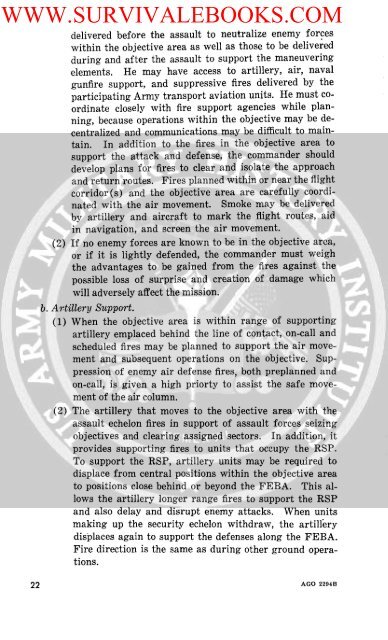FM 57-35 Airmobile Operations - Survival Books
FM 57-35 Airmobile Operations - Survival Books
FM 57-35 Airmobile Operations - Survival Books
- No tags were found...
Create successful ePaper yourself
Turn your PDF publications into a flip-book with our unique Google optimized e-Paper software.
WWW.SURVIVALEBOOKS.COMdelivered before the assault to neutralize enemy forceswithin the objective area as well as those to be deliveredduring and after the assault to support the maneuveringelements. He may have access to artillery, air, navalgunfire support, and suppressive fires delivered by theparticipating Army transport aviation units. He must coordinate closely with fire support agencies while planning, because operations within the objective may be decentralized and communications may be difficult to maintain. In addition to the fires in the objective area tosupport the attack and defense, the commander shoulddevelop plans for fires to clear and isolate the approachand return routes. Fires planned within or near the flightcorridor(s) and the objective area are carefully coordinated with the air movement. Smoke may be deliveredby artillery and aircraft to mark the flight routes, aidin navigation, and screen the air movement.(2) If no enemy forces are known to be in the objective area,or if it is lightly defended, the commander must weighthe advantages to be gained from the fires against thepossible loss of surprise and creation of damage whichwill adversely affect the mission.b. Artillery Support.(1) When the objective area is within range of supportingartillery emplaced behind the line of contact, on-call andscheduled fires may be planned to support the air movement and subsequent operations on the objective. Suppression of enemy air defense fires, both preplanned andon-call, is given a high priorty to assist the safe movement of the air column.(2) The artillery that moves to the objective area with theassault echelon fires in support of assault forces seizingobjectives and clearing assigned sectors. In addition, itprovides supporting fires to units that occupy the RSP.To support the RSP, artillery units may be required todisplace from central positions within the objective areato positions close behind or beyond the FEBA. This allows the artillery longer range fires to support the RSPand also delay and disrupt enemy attacks. When unitsmaking up the security echelon withdraw, the artillerydisplaces again to support the defenses along the FEBA.Fire direction is the same as during other ground operations.22 AGO 2294B
















